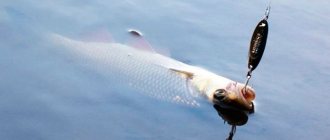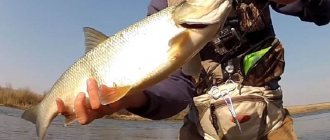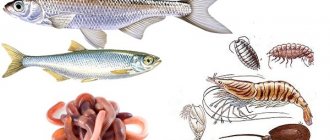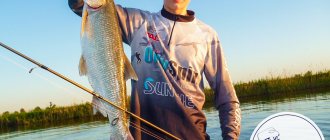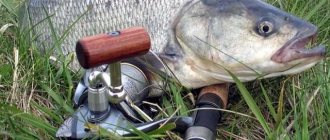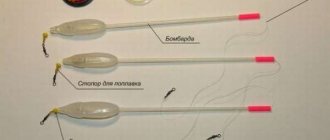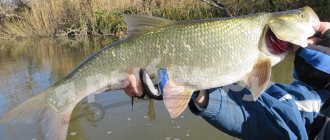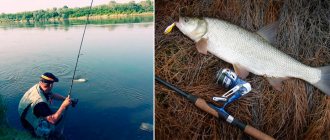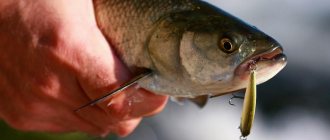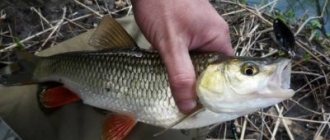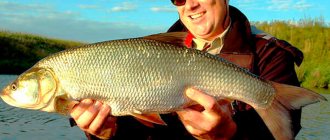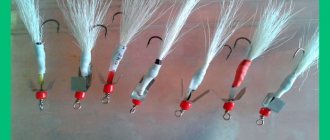Among the huge variety of baits for catching asp, castmaster is one of the most effective. Today it is used by both beginners and professional fishermen who go in search of a careful and thoughtful predator.
Features of the bait
Externally, the castmaster is a spoon made of a metal rod with cut corners, to which winding rings and a tee are attached. Sometimes spinning anglers place bright feathers or petals on their hooks, which arouse special interest in the fish. The average weight of the bait varies from 7 to 35 grams, and the classic color option is silver-white.
The main advantage of the castmaster is its excellent aerodynamic properties, since its body has increased mass, low windage and compact dimensions. This provides a greater casting range, which is important when fishing on the shore or casting equipment in strong winds. This feature is extremely important for asp fishing, because this predator rarely swims close to the shore and tries to stay away from potential danger.
The absence of intense drag on the spinner ensures uniform wiring, regardless of the intensity of the current. The sluggish action of the bait attracts fish that have set up an ambush and are waiting for available prey. The castmaster is also characterized by the ability to maintain one depth horizon during classic retrieves at medium speed.
But despite the lack of a complex design, only the original castmaster is a truly effective bait. Any cheap fakes and homemade analogues are far from a branded spinner, so at the selection stage you need to carefully check the product for authenticity.
Preparation of equipment
To successfully catch asp with a castmaster, you need to use a medium-class plug rod with a semi-fast action and a length of 2.1-2.7 meters. There is no need to use longer forms, because... The spoon itself flies quite well. The optimal test range varies from 7 to 30 grams. With this rod you can explore any water area without sacrificing the attractiveness of the game.
The reel used is an inertia-free version with a high gear ratio, several bearings and a good brake. The capacity of the spool should be at least 100 meters for braided fishing line with a diameter of 0.15-0.18 mm.
To avoid mistakes when installing the equipment, it is necessary to take into account the following recommendations from experienced fishermen:
- Sometimes, instead of the factory treble hook, any other suitable treble hook is used. The main thing is that it corresponds to the size of the future prey and has a sharp tip.
- When fishing for asp, you need to constantly monitor the condition of the points of the hooks, since they often become blunt when colliding with a hard bottom.
- Casting fishing is carried out using a spinning rod 2.2-3.5 m long. If you need to fish from the shore, then longer models are allowed. And when exploring hard-to-reach places and when fishing under cliffs or from a boat, it is better to choose short rods.
- The fishing line can be used either braided or monofilament. The second option should have a thickness of 0.18-0.26 mm. The monofilament has good elasticity and is invisible in water. It also sails less when exposed to wind. It is important to choose a fishing line that does not have a “memory effect”. This will allow you to accurately cast the bait and maintain an attractive game.
- If fishing is carried out from a watercraft, it will not hurt to have a release that will allow you to get the tackle out of the water if it gets caught on a snag or other object at the bottom.
Using fluorocarbon leaders
When preparing gear for catching asp with a castmaster, it is important to take care of a good leash. It is advisable to give preference to fluorocarbon models, since this material is invisible to predators and can withstand strong jerks from resisting fish.
However, the market offers a lot of cheap analogues of fluorocarbon, where it is used only as a shell. This option does not justify itself, because it quickly loses its properties and becomes damaged. The original models are not capable of letting water through or losing quality when exposed to the sun. They are quite expensive, but last much longer than fakes.
The advantages of fluorocarbon leashes include:
- Almost completely invisible in the water, even if it is transparent, and the fish is extremely cautious.
- Lack of stretchability and “memory effect”. The leash never stretches or loses its original shape.
- Quick dive to depth.
- No vulnerability to temperature fluctuations.
- No water absorption.
Depending on the size of the expected production, you need to choose the following leash diameters:
- 0.14 mm - can withstand loads of more than 1.36 kg.
- 0.16 mm – can be used for catching fish weighing up to 1.83 kg.
- 0.18 mm – intended for catching asps weighing up to 2.17 kg.
- 0.2 mm – can withstand loads of up to 4 kg.
If there is a chance to catch trophy prey weighing more than 6 kg, it is better to use a fluorocarbon leader with a diameter of 0.31 mm.
Catching asp with castmaster
Spring asp is the best fish for hunting. Believe me, every fisherman dreams of catching such a fish, and not just a simple one, but a bigger one! And such a spinner as the castmaster will cope with this task perfectly. This is exactly the type of spinner that you can customize for yourself. If you wish, you can even make a spinner yourself, however, here it all depends on your personal abilities and dexterity of hands.
Castmaster for asp has its advantages. Firstly, as mentioned earlier, it has the necessary heaviness that can help with long casting. Secondly, the simplicity of the design, because a castmaster can be made even from scraps of pipe and nuts. Thirdly, ease of use. Here the bait speaks for itself! Its heaviness allows you to cast the fishing rod into places with strong currents, and it is also convenient to wait for the moment. Experienced fishermen advise throwing the fishing rod directly into the center of the boiler and letting the bait lie in place for a while. Anyone, even a large asp, will soon forget that he is being hunted, and the castmaster himself will attract even the most cautious fish, which is the biggest plus!
If you want to choose a good castmaster for catching asp, then take a silver model: it is clearly visible in the water column, as well as through algae and silt, attracting the attention of the asp. As for the weight, then take a spinner, the mass of which will be about forty grams. The material can be anything: brass, stainless steel, bronze, plastic. The coating can also be absolutely anything, here everything depends on your desire. In any case, the main thing is that the castmaster moves well in the water, resembling a real fish, and also that it can be cast far. As we mentioned earlier, the spinner should therefore have an elongated shape.
Source: velesovik.ru
Specifics of castmaster wiring
A useful property of the castmaster is the ability to survey any water horizon by changing the reeling speed. So, the faster the angler pulls in the line, the higher the spoon floats, and vice versa.
If you use a “fall” retrieve, then you must follow the same tactics as in the case of jig fishing, alternating pull-ups with pauses. But it is important to remember that the asp can be active when the bait is rising, and not when it is lowering.
When using a “lifting” retrieve, you need to slightly lower the spoon to the bottom, then perform a smooth rise 45-50 degrees upward, and stop the bait for 5-10 seconds. This is followed by a slight pull of the rod by 50-90 cm, reeling in the fishing line and stopping. This option is effective only when examining water areas with a clean bottom. It is also possible to use mixed postings, where different methods of conducting a castmaster are combined in order to determine the most effective option.
The intensity of bites directly depends on the depth of immersion of the product. Thus, the asp prefers to pounce on those baits that swim in its visibility zone and only occasionally pays attention to the prey floating above. In the same way, he is not interested in spinners located at the very bottom.
Some anglers take the position that the castmaster should be carried out at the very surface, but this does not always pay off. To find the ideal horizon, you need to first study the water area and the behavior of the fish. The “golden mean” is to lower the bait by 0.20-0.80 cm. If the reservoir is deep, you can submerge the castmaster by 1.5-2 meters.
If there is no stable bite, you can slightly improve the tackle by equipping the spinning rod with an additional leash with some kind of bait, such as a twister or wobbler. This structure is placed above the main spoon.
But since many rivers have a lot of snags, stones and other obstacles at the bottom, the method is ineffective.
Catching asp with castmaster and fly
The addition of an additional type of bait to the spinner is also due to the low activity of the predator. The fly is mounted on a short and fairly rigid, up to 30 cm, lead, mounted in front of the spinner on the main cord at a distance of 20 cm. Despite the additional ties, due to the range of the spinner, the rigs fly well over long distances. When retrieving in combination, installation with additional chaotic movements of the hairy fly irritates the passive trophy, which in the end, in most cases, attacks the spinner when it stops. For the most part, this feeding option is used to catch baits in the upper layers of water.
Fishing process
If the angler has followed all the rules for guiding the castmaster and the asp has responded to the bait, all that remains is to correctly remove it from the water. Haste in this matter is the main mistake of beginners. Trying to pull the trophy ashore as quickly as possible, they quickly reel in the fishing line, but this allows the fish to make a jerk and free itself.
When fishing for individuals weighing more than 5 kg, you must be extremely careful and patient. It is also important to go fishing with a good landing net with a mesh made of thick fishing line. When faced with resistance from a large asp, you need to force him to expend a lot of energy and get tired. To do this, you need to keep the line in tension and absorb sudden jerks with the help of a fishing rod or a friction brake.
Search for asp
The key to successful asp fishing with a castmaster is the correct choice of casting location. It is known that this predator likes to stop in large rivers with medium currents and any depth. When choosing a point for hunting or parking, he is guided only by the placement of prey, especially bleak.
In spring and summer, asp can be found in the upper horizon, at a close distance from forage fish. In the autumn, it goes to medium and deep depths, following small fish preparing for wintering.
Unlike other predatory representatives of freshwater bodies, the asp does not like areas with heavy thickets or snags. He is more interested in wide water areas and the boundaries between fast and slow currents.
In summer, the predator reveals itself with loud splashes on the surface when it suppresses small prey.
Technique for catching asp using castmaster
Asp are caught everywhere using castmaster. Having noticed a predator fighting on the water, you can safely move to a promising point and begin fishing.
Important! When casting bait, you need to try to throw the cauldron ten meters so as not to scare away the hunting fish by hitting the water with the spoon.
Having submitted the spinner to a promising place, the angler makes the necessary pause for the fishing tool to reach the required water horizon and only then begins the intended animation. We will consider the main stages of fishing techniques in more detail in the continuation of the material.
Wiring a castmaster when catching asp
Wiring a castmaster with a spinning rod when catching asp has four main fundamental differences, which are used based on the conditions available at the time of the hunt. When fighting fish with fry in the upper layers of water, wiring is used that allows the spoon to be driven in the upper layers of water. To do this, take the lightest variants of the bait and immediately after casting, without allowing the tool to go deep into the water, they begin a uniform, monotonous winding of the cord, leading the spoon at the same speed, along a trajectory passing through the center of the noticed boiler. The bait plays with its planes as a result of the factory settings.
Important! This result of the game is given by the winding ring, through which it is attached to the fishing line and in no case should it be removed from the spoon and replaced with a swivel. Changing the ring radically changes the performance of the bait.
The next method is based on the cyclicity of monotonous surface wiring with a short pause and a sharp toss of the tool. At the moment of the wiring described above, after the same period of time, the fisherman pauses for half a second, allowing the bait to go deeper 0.5-1.0 meter below the wiring level. subsequently a toss is made to the original trajectory. As a result, we get something similar to the fry collapsing from loss of orientation, which is what the asp is guided by when picking up stunned victims.
The fishing methods described below are carried out in deep layers, when the fight of fish is not visually determined, but there is confidence in its presence in the fished area.
Pelagic jig helps to catch fish that feed in the middle layers of water. Retrieving is carried out in steps with different frequency pauses and the same intensity of reeling without the spoon touching the bottom of the reservoir. The interest of the bait is caused by the possibility of its natural fall, which tempts the predator to attack.
Bottom jigs are carried out at high throws, which is achieved by rotating the reel handle not two or three times, but an order of magnitude larger number. The bait falls to the bottom from a greater distance, and when it touches the bottom, it makes a peculiar sound, attracting the trophy to the fishing area. The cord is wound at a slow pace.
Important! High-speed retrieving causes fear among asps, and bites at fast reeling rates almost never happen.
How to choose a castmaster
For a long time, only five versions of Kastmaster were sold on the market, which weighed from 7 to 35 g. Soon the manufacturer decided to expand its range and began producing small products and intermediate options. To choose a catchable bait, it is important to consider both the fishing conditions and the size of the expected trophy.
The market offers baits with silver and golden colors, options with holographic stickers and combined colors. When choosing the appropriate option, you should be guided by personal preferences and the specific behavior of fish in a particular body of water.
